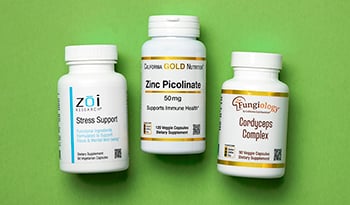Look for Cleaner and More Efficient Supplements in 2022
DISCLAIMER:This blog does not intend to provide diagnosis...
- In this article:
- New Formulations: Gummies and Liquids
- Purity and Reduced Fillers
- Active and Optimal Forms of Ingredients
- Enhanced Absorption
- Better Combinations
- Sustainability
- Conclusion

New trends are common in the dietary and nutritional supplement industry. And with 2021 coming to a close, it’s worth looking ahead to 2022. Not surprisingly, the supplement industry is continuing to evolve in ways to support consumers, expand options, and deliver cleaner, more effective products. These strategies will likely continue to advance through 2022 and beyond. As such, it is worth recognizing several different product trends to look for in 2022.
New Formulations: Gummies and Liquids
Historically, most nutritional supplements did not focus on flavor except in chewable or liquid products for children. More recently, flavored products aimed at adults are becoming more commonplace. Gummy vitamins and minerals are widely available. Some herbal products, like ashwagandha and elderberry, are also available as gummies, giving consumers an increased number of options and supplement forms to choose from.
In addition to gummies, more liquid supplements and formulations are also available. Liquid nutrients typically offer the advantage of better absorption. By providing a supplement in a liquid form, you dramatically increase the dispersion of the ingredients, allowing for easier assimilation along the digestive tract. Liquid nutrients, like iron, calcium, and magnesium, are readily available. Newer products like liquid collagen or liquid multivitamins are also gaining popularity.
While an interesting approach, gummies, and liquids do present some challenges. Many nutrients and herbs do not taste good, which may limit the amount and number of active ingredients found in products due to flavor issues. It’s always worth checking with any gummy or liquid product to see how much of each ingredient is included. In some cases, it may be under the threshold needed to provide the desired effect. In certain situations, traditional capsules may be a better option to achieve adequate dosing.
Purity and Reduced Fillers
As consumers become more knowledgeable, they often demand better quality or cleaner products. Due to manufacturing challenges or for aesthetic reasons, companies will add excipients, including flow agents, dyes, lubricants, binders, and other fillers, during production. A growing trend in the supplement industry is for “cleaner” products that either minimize or eliminate the presence of these additives.
Numerous nutritional supplements, from multivitamins and herbal products to individual nutrients, like vitamin C and zinc often contain added fillers to simplify manufacturing. While more research is needed, many common fillers have research that raises at least some potential concerns. Some fillers, flow agents, and binders may cause inflammation in the gastrointestinal tract or disturb the gut flora. Some additives that may be of concern include maltodextrin, carboxymethylcellulose, carrageenan, titanium dioxide, and silicon dioxide (based on particle shape and size). Artificial sweeteners, often added to improve taste, also appear to affect gut flora in potentially negative ways.
As research continues to accumulate suggesting potential problems with these added ingredients, consumers are starting to demand products that are free of them. While more difficult to manufacture, supplements that are free of fillers continue to grow their market share, with some companies starting to specialize in bulk powders, often used for collagen and protein, to provide only the active ingredient without any additional additives.
Active and Optimal Forms of Ingredients
Trends toward more “biochemically” active formulations are likely to continue to become more available through 2022. The active forms of nutrients require minimal to no enzymatic changes to be utilized, making them more readily bioavailable. Often encountered with the B-complex vitamins, including vitamins B2 (as riboflavin 5’-phosphate), vitamin B6 (as pyridoxal 5’-phosphate), vitamin B12 (as methylcobalamin), and folate (as methylfolate), active formulations are increasing in popularity.
Using more available forms of a nutrient can also be important for certain minerals. While calcium carbonate is still common, it requires stomach acid for absorption. Other forms of calcium, like calcium citrate, do not. Similar problems around absorption exist with magnesium, with chelated and more water-soluble versions often providing better uptake. Recent research even suggests that a particular form of magnesium, magnesium threonate, may be better at providing benefits to the brain than other forms of magnesium. As such, some companies are choosing different types or forms of minerals to better address consumers' health concerns and needs.
Enhanced Absorption
Other dietary supplements that face absorption challenges are also getting new types of formulations, including liposomal and nanoparticle varieties. In some cases, additional ingredients can be added to enhance absorption, like black pepper extract, enzymes, or lecithin. Common products that use special formulations to enhance availability include curcumin and other difficult to absorb “polyphenols” like quercetin.
Liposomes are tiny spheres composed of phospholipids—compounds that are both fat and water-soluble. These tiny spheres can be loaded with different nutrients or other ingredients to more effectively bypass absorption issues. Vitamin C, above a certain threshold, is poorly absorbed. To increase absorption, companies have started to offer liposomal varieties. While vitamin C is one of the most common, other liposomal products, like the antioxidant glutathione, are starting to become available as well.
Nanotechnology also holds promise and pitfalls for the dietary supplement industry. By making the particle size of an ingredient extremely small, some compounds have increased absorption. However, nanoparticles can have completely different interactions in the body as compared to normal, larger particles. While nanotechnology is most commonly encountered in mineral sunscreens and as colloidal silver, it’s likely to expand rapidly into other nutritional supplements. With adequate testing for safety, nanotechnology may offer some advantages over older formulations.
Better Combinations
Over the last couple of years, demands for immune-based and digestive formulations have increased. This increased demand has increased options throughout the industry and pushed the growth of newer and more varied products to support immune and digestive health. Products using combinations of zinc, vitamin C, echinacea, and elderberry have often been hard to come by as manufacturers have worked to meet the increased demand. Newer products based on supporting the microbiome, including probiotics and prebiotics, have also increased in popularity. Considering their documented benefits for decreasing a person’s susceptibility to respiratory infections, it’s not too surprising that probiotics have been popular.
Sustainability
As individuals and corporations realize more of the ecological challenges facing our planet, manufacturing and sustainably distributing supplements has also increased in importance. Supplements commonly use plastic bottles and packaging. However, some companies turn to alternatives, using plastic-free compostable or recyclable pouches or containers.
Shipping materials also commonly include plastic, styrofoam, or other difficult to recycle materials. Some companies are moving away from plastics and styrofoam, using cardboard, paper, and corn-starch-based packing peanuts or foam.
Manufacturing can be a polluting, energy-intensive process, releasing a lot of carbon dioxide and other compounds into the atmosphere. This pollution raises obvious long-term concerns for the effects on the climate and the planet. Several forward-thinking companies have focused on reducing energy demands and improving air quality standards for their facilities, working to “green” their technology and tread more lightly on the planet’s surface. It is worth watching for companies moving in a more sustainable direction and supporting these approaches when possible.
Conclusion
There is a lot to look forward to in the dietary and nutritional supplement industry for 2022 and beyond. From improved formulations to increased sustainability, companies are listening to consumers and offering products that better meet their needs. As the year unfolds, it’s worth seeking out some of these newer approaches and considering them for your personal use, especially where they provide advantages over older formulations.
References:
- Borthakur A, Bhattacharyya S, Anbazhagan AN, Kumar A, Dudeja PK, Tobacman JK. Prolongation of carrageenan-induced inflammation in human colonic epithelial cells by activation of an NFκB-BCL10 loop. Biochim Biophys Acta. 2012;1822(8):1300-1307. doi:10.1016/j.bbadis.2012.05.001
- Laudisi F, Di Fusco D, Dinallo V, et al. The Food Additive Maltodextrin Promotes Endoplasmic Reticulum Stress-Driven Mucus Depletion and Exacerbates Intestinal Inflammation. Cell Mol Gastroenterol Hepatol. 2019;7(2):457-473. doi:10.1016/j.jcmgh.2018.09.002
- Liu F, Hou P, Zhang H, Tang Q, Xue C, Li RW. Food-grade carrageenans and their implications in health and disease. Compr Rev Food Sci Food Saf. 2021;20(4):3918-3936. doi:10.1111/1541-4337.12790
- Mordor Intelligence. DIETARY SUPPLEMENTS MARKET - GROWTH, TRENDS, COVID-19 IMPACT, AND FORECASTS (2021 - 2026). Published 2020. Accessed December 23, 2021. https://www.mordorintelligence.com/industry-reports/dietary-supplement-market
- Ogawa T, Okumura R, Nagano K, et al. Oral intake of silica nanoparticles exacerbates intestinal inflammation. Biochem Biophys Res Commun. 2021;534:540-546. doi:10.1016/j.bbrc.2020.11.047
- Rinninella E, Cintoni M, Raoul P, Gasbarrini A, Mele MC. Food Additives, Gut Microbiota, and Irritable Bowel Syndrome: A Hidden Track. Int J Environ Res Public Health. 2020;17(23):8816. Published 2020 Nov 27. doi:10.3390/ijerph17238816
- Sadir S, Tabassum S, Emad S, et al. Neurobehavioral and biochemical effects of magnesium chloride (MgCl2), magnesium sulphate (MgSO4) and magnesium-L-threonate (MgT) supplementation in rats: A dose-dependent comparative study. Pak J Pharm Sci. 2019;32(1(Supplementary)):277-283.
- Shade CW. Liposomes as Advanced Delivery Systems for Nutraceuticals. Integr Med (Encinitas). 2016;15(1):33-36.
- Suez J, Korem T, Zeevi D, et al. Artificial sweeteners induce glucose intolerance by altering the gut microbiota. Nature. 2014;514(7521):181-186. doi:10.1038/nature13793

 By Dr. Scott Buesing, N.D.
By Dr. Scott Buesing, N.D.


